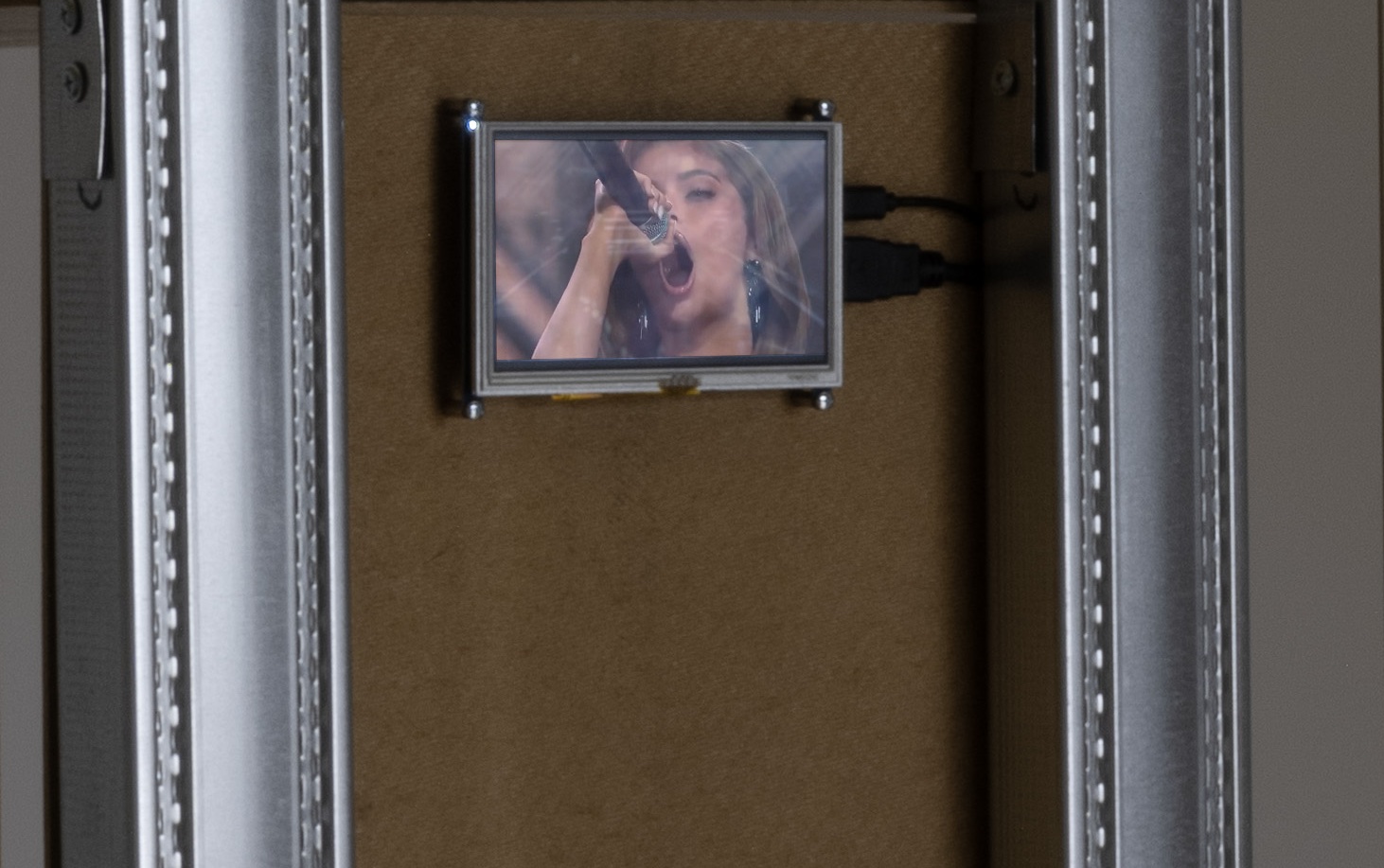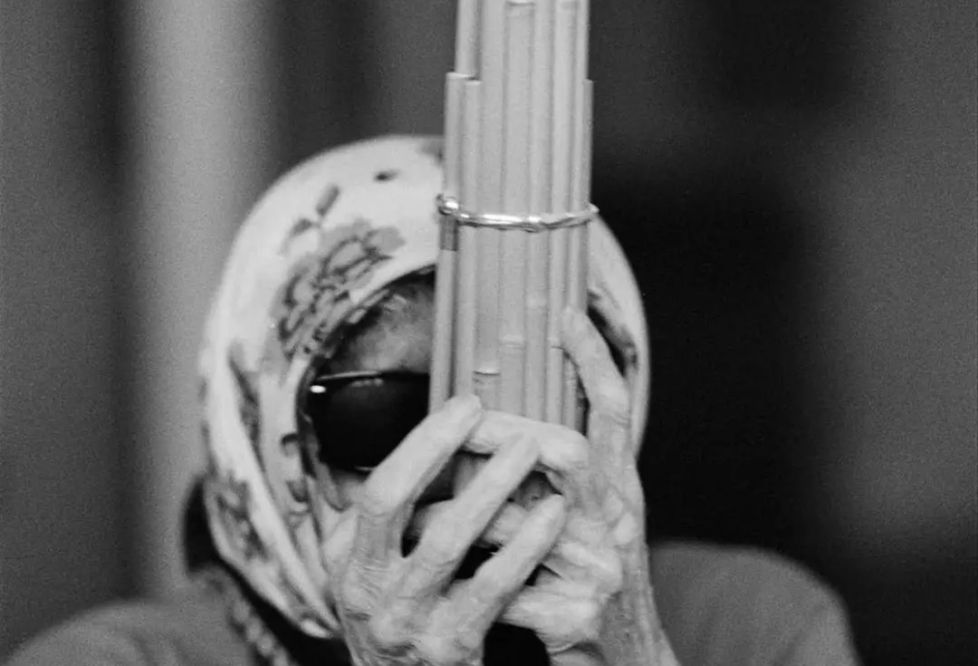
Judith Hopf’s exhibition in the Malmö Konsthall project space is a stringent, sober affair. In all its sheer simplicity it consists of three ultra-short films presented on individual monitors and a wooden frame installed in the room; a kind of extra portal you need to pass through and whose function as a barrier – the exhibition’s overall leitmotif – is accentuated by a fake glass door placed in the middle of the structure (the door is made of safety glass with a handle drawn on in felt pen). The final element of the exhibition is a long dressage whip leaning against the wall. At first glance the exhibition appears like a kind of presentation. But upon leaving it you have the sense of having seen a kind of sophisticated micro-retrospective.
Judith Hopf (b. 1969) belongs to the political fraction of the Berlin art scene. She represents an “old school” Berlin dating back to the time before the city became a hip European art mecca, a time when it was still a centre for the radical left, for squatters and anti-capitalist movements. However, Hopf’s art is not political art in an overtly agitational sense, for at the same time Hopf belongs to a subset of German contemporary art that is defined by a very attitude-conscious position on matters of politics and aesthetics. Hopf can be said to belong to the political end of this spectrum, while artists such as Sergej Jensen represent the purely aesthetic division. Occupying various positions within this spectrum we find artists such as Henrik Olesen (with whom Hopf has created several collaborative works) and Josef Strau. All these artists have been featured at Malmö Konsthall during Jacob Fabricius’ time in the director’s seat, which makes it particularly fitting that Hopf, too, should be presented here.

The deliberate attitude that infuses Hopf and several other artists gives rise to an artistic mode of expression that appears hermetic and eccentric in equal measure – and which is very much borne up by specific gestures and allegiances. For example, it is a typical trait – reminiscent of the 1980s Cologne scene – that the entire subset of the art scene in which these artist move, and the persons with whom they socialise, have considerable impact on their art; they may even be featured directly in their work. The film Türen (2007) by Hopf and Olesen, which is shown at the exhibition, features the artists Danh Vo, Mandla Reuter, and several other figures from the creators’ circle. Strictly speaking you need not be aware of this in order to decode the humorous and simple three-minute film, which shows a number of different people (some of them dressed in blue leisurewear bearing the legend “Polizei”) in a white, impersonal institutional setting, entering and leaving through a number of doors. Reuter undoubtedly appears absolutely convincing in the role of a policeman walking out the door while carrying an Ikea bag full of laundry. Yet this reference to the artists’ own personal circles certainly adds meaning that go beyond a mere humorous reference for those in the know. By employing their circle of friends the artists are lampooning power and disrupt the narrative of a film which can be said to address issues of power at a basic level: Who has access? Who governs the open and closed doors? Who has the power to gain access to new spaces, whether social or political? At the same time the use of amateur actors also help to puncture the overall mode of expression, adding a carefully considered and deliberately “ragged” or unprofessional quality.

In the final analysis the inclusion of the artists’ own circle is also an idealistic, Romantic device, reflecting a belief that you can and should create your own space; a sentiment in the vein of that old chestnut “art and life”. That is why Hopf often appears in her own films and seems to pay little heed to set design. The objective is not to create a likeness, but to accentuate the absurdity of the situation; in this case in the relationship between power and identity, which is why it makes sense that the overall feel should remain unsettled – like sketches for a statement. One of the few exchanges in Türen can be regarded in this light. Hopf knocks on a door, eliciting the response: “Wer ist da?” (“Who is it?”), to which Hopf replies: “Ich bin’s” (“It’s me”). We then get a brief glimpse of Olesen opening the door to let her in. Utterly banal, almost trite. Yet at the same time this exchange says everything – about who has access to what spaces, including those spaces that might appear easily accessible at first glance, such as those fitted with glass doors that you can see through. Yet you cannot actually pass through them; your progress is impeded by the glass wall, which may even be made out of safety glass (cf. the installation with the fake glass door). And who needs this safety, this protection? Protection for and from whom? Them or us? And who are they – or, more accurately: “Who is it?” – “It’s me”. Hopf’s project often addresses this kind of «body control» or biopolitics.

The long acrylic glass whip, wound with coloured tape and nylon strings, is a reference to the film Zählen! (2008), which is about a mathematically gifted horse. The film shows Hopf grooming the horse. In between the grooming scenes the film cuts to three black, glossy BMWs racing through forests and landscapes, reminiscent of killer squads on the move in a thriller movie. They arrive at the farm where Hopf is attending to the horse and step out of the cars. The figures turn out not to be assassins, but a kind of “business clowns”, dressed in white shirts and trench coats, their cheeks made-up in a vivid red. They regard the horse with suspicion, laughing scornfully, but proceed to challenge its ability by asking it questions such as “Sieben minus vier?” (“Seven minus four?”). After which the horse stomps the correct answer out on the ground. The narrative refers to the true story about Hans the horse whose mathematical talents caused a media sensation in the early 20th century. It later emerged that the horse probably couldn’t do arithmetic at all, but that its ability to read audience responses and expectations enabled it to stop at the right number. The “Clever Hans effect” subsequently became a concept within behavioural psychology.
Judith Hopf’s art certainly falls within the “acquired taste” category. For the uninitiated these short films featuring policemen passing through doors or clowns challenging a horse to do arithmetic undoubtedly seem deadpan, silly, and slightly annoying – which they certainly are. Yet the endeavour is also a serious one, and that makes it difficult to speak about Hopf’s works. In this regard the other exhibition staged at the Konsthall – the major autumn exhibition featuring Mike Nelson – offers a mirror capable of reflecting Hopf’s project in a relevant manner.

Nelson’s uniform concrete models, which cover the venue’s giant floor area in a repeated geometrical pattern, serve as a perfect illustration of the Anglo analytical method. Even though the title, 408 tons of imperfect geometry, refers to the incomplete nature of the pattern, it is not difficult to deduce/induce the plan for how the pattern may be expanded. A definite contrast to Hopf’s ragged, unpolished mode of expression, to the Continental sense of doubt that she is always pushing in front of herself, making it impossible to figure out her next move. What is more, the two artists have opposing views on the issue of “craft” – or work ethics, if you wish. Whereas careful craftsmanship and colossal effort are fundamental aspects of Nelson’s project (so fundamental that the issue is always mentioned, e.g. “it took him five weeks to make the wallpaper look as if it’s been on that wall since 1912”), Hopf’s film conveys the impression that it hardly took any longer to produce the three-minute “radio edit” of the film than it takes us to watch it. Of course that is not the case.
A certain wariness of work and perfection is an implicit feature of Hopf’s counter-Capitalist project and a crucial part of the explanation behind the deliberate slacker-like attitude and the always somewhat tattered, winged overall expression. Perhaps, then, Judith Hopf’s aesthetic-political project is best described as doubtful. Doubtful – as in anarchistic, entirely open yet brimful of definite attitudes, strange and silly, yet also created in dead earnest. In short: doubtful as in excellent.








